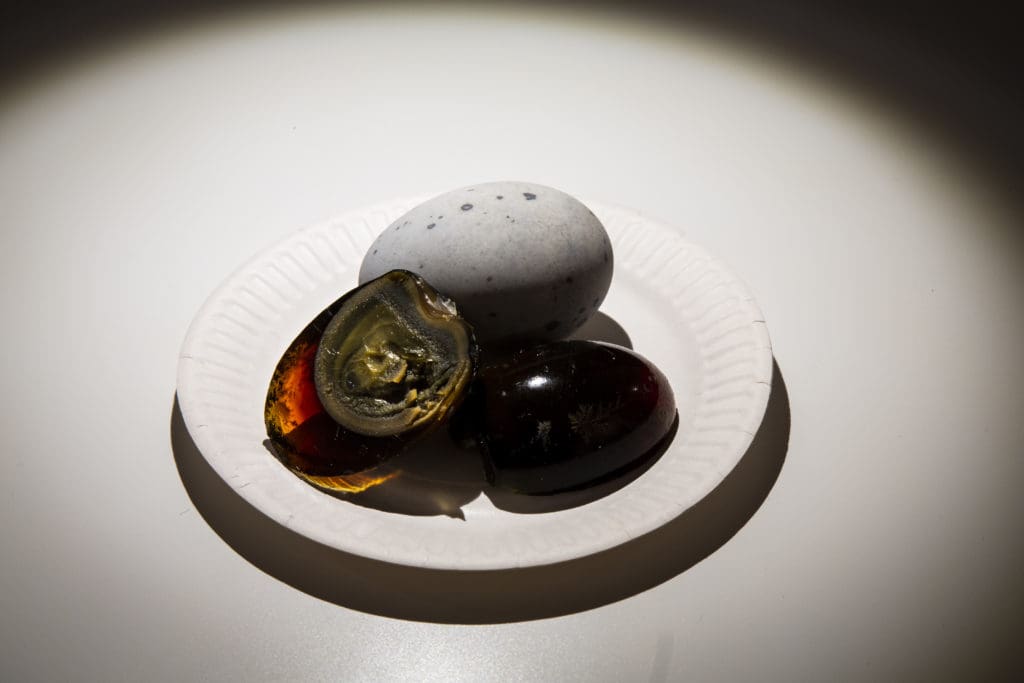Century eggs (Chinese: 皮蛋; pinyin: pídàn) are very popular in China and Hong Kong alike, but also served in Chinese restaurants around the globe. It was featured in the Disgusting Food Museum since its inception. This traditional Chinese food is made with a mixture of alkaline clay, quicklime, salt and ash and is a staple in Chinese cuisine. It’s commonly eaten with congee, a Chinese rice porridge, along with soy sauce or sesame oil. It may not be understood in western culture, but it’s a very common food in Asia.

History
The discovery of this Chinese delicacy, though not verifiable, was said to have occurred around 600 years ago in Hunan during the Ming Dynasty, when a homeowner discovered duck eggs in a shallow pool of water with slaked lime that was used for mortar during construction of his home two months before.
Century eggs can be found all across China, especially in Hunan province. It’s also called Millennium egg, thousand-year egg, or Hundred-Year egg. The preservation method is used to prolong the shelf-life considerably when you have a lot of them.
There is a tale about a man who found an old hen laying eggs while digging up soil near a riverbank. He took one of these eggs back to his house and kept it under his bed. When he went to sleep, however, he awoke to find that the eggshell had cracked open revealing a beautiful yellow yolk inside. This inspired him to try making other kinds of eggs using different materials.
Traditional methods of century egg production
Most recipes begin with a duck egg but you can also use a chicken egg, goose egg or quail egg. Instead of using just clay, a mixture of wood ash, calcium oxide (also known as quicklime), and salt is included in the plastering mixture, thereby increasing the pH of the sodium content. 1.4 kg of tea is inflused in water and 1.4 kg of calcium oxide, 4.1 kg of sea salt, and 3.2 kg of ash from burned oak is added and mixed into a smooth paste. Each egg is individually covered by hand, with gloves worn to protect the skin from chemical burns. It is then rolled in rice hulls, to keep the eggs from sticking to one another, before the eggs are placed in cloth-covered jars or tightly woven baskets. The rice husks prevent the eggs from sticking to each other.
Modern methods of century egg production
Century eggs are made from pasteurized or homogenized whole eggs that have been soaked in an alkaline solution containing various chemicals such as potassium bicarbonate, sodium carbonate, sodium hydroxide, and/or calcium hydroxide. The mixture may also contain other ingredients including sugar, gelatin, glycerin, citric acid, and food coloring. After being left undisturbed at room temperature for about two months, they will be ready to eat. Sometimes toxic chemicals like lead oxide is used to speed up the reaction, leading to poisoning. Zinc oxide is the preferred alternative.


Safety
Several incidents of malpractice in the century eggs production has been found over the years, causing contaminated and dangerous eggs. In 2013, three factories in Jiangxi province used industrial copper sulphate to make the production time shorter. It contained toxic chemicals and heavy metals, causing injuries in the people that ate the eggs. After the incident was exposed on China’s national broadcaster CCTV, causing local officials to shut down 30 factories for inspection. In order to ensure safety during processing, all eggs must pass a series of tests before they can be sold as “century eggs”:
- Eggs should not contain any foreign materials such as dirt, dust, hair, feathers, insects, etc.
- They should weigh between 100g and 120g each.
- Their shells should be smooth without cracks or holes.
What Does a Century Egg Taste Like? Does a Century Egg Taste Good?
Century Eggs are known for having a strong sulfuric smell. This is caused by the presence of lactic acid bacteria present inside the eggshells. These bacteria produce acetic acid when they metabolize sugars from the egg whites.
This acidic compound causes the formation of carbon dioxide gas bubbles inside the eggshells which makes the egg more porous and easier to absorb moisture. As a result, the egg gets softer and darker in color.
The taste can be described as an over boiled egg, a bit mushy and with a taste some liken to mushrooms. If you take too big of a bite, the egg tends to grow in the mouth of unaccustomed eaters.
Are Century Eggs good for your health?
They are rich in vitamins and minerals though, with high concentrations of vitamin A, and calcium. Some say that consuming century eggs helps prevent cancer while others claim that it prevents heart disease. Others claim that the consumption of the brown eggs can improve your skin and strengthen your nails due to the high levels of sulfur amino acids. The sulfur also have negative effects though, since it can build up in the arteries and cause blood vessel inflammation if you eat century eggs too often. It’s common in Chinese culture to eat the “Thousand-year-old egg” daily and you can find it in most Asian supermarkets.
Misconceptions
Vicious rumors claim they are steeped in horse urine, something that is of course a complete fabrication. Horse urine is not even alkaline, something that is needed to make century eggs. One reason for the misconception might be that in Thai and Lao, the local words for century eggs actually translate to horse urine eggs. Others might confuse it with Virgin boy eggs, that is prepared with urine, but not from horses.
Would you try century eggs?
Well, you have your chance, it’s featured in the tasting bar at the Disgusting Food Museum.

